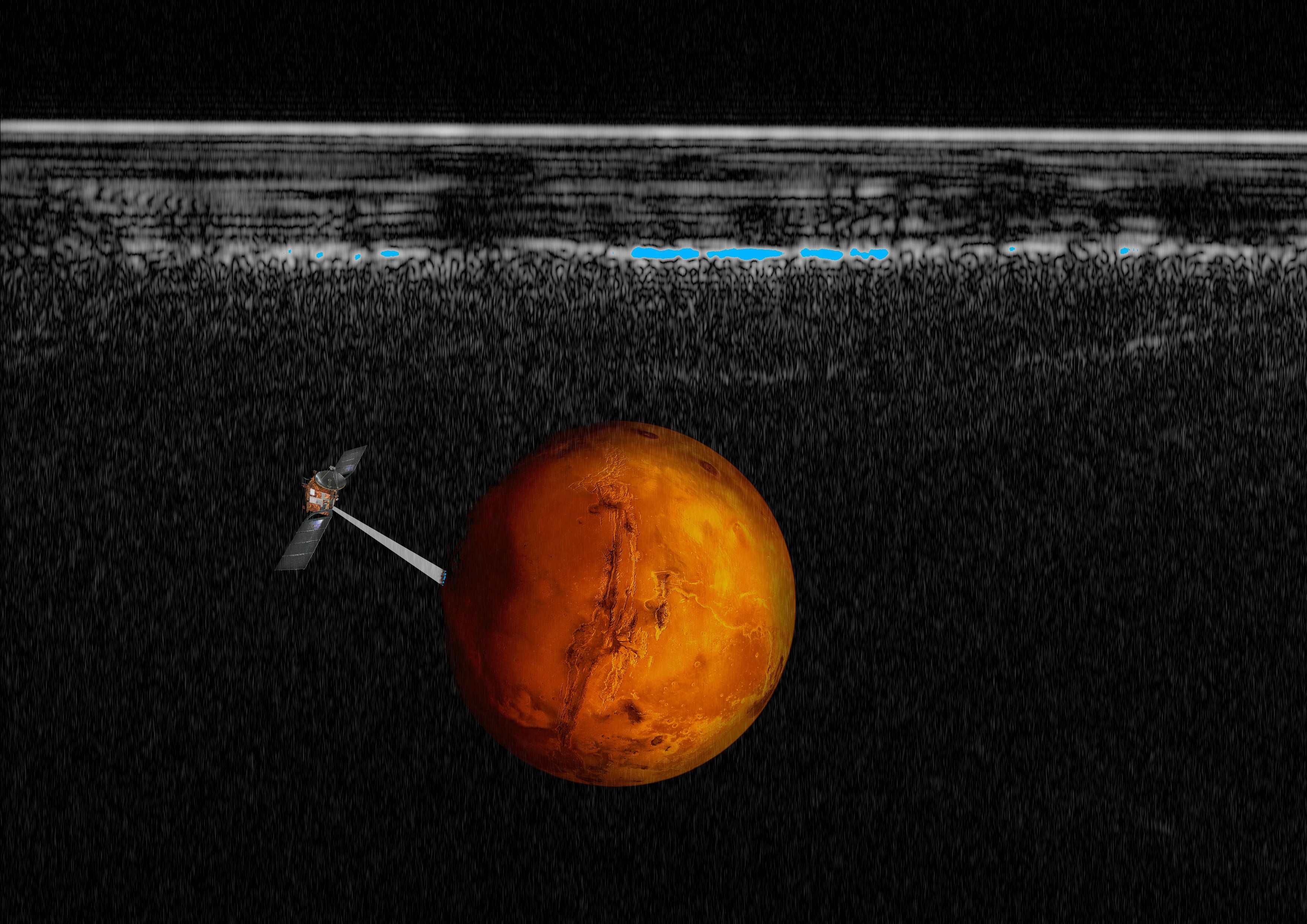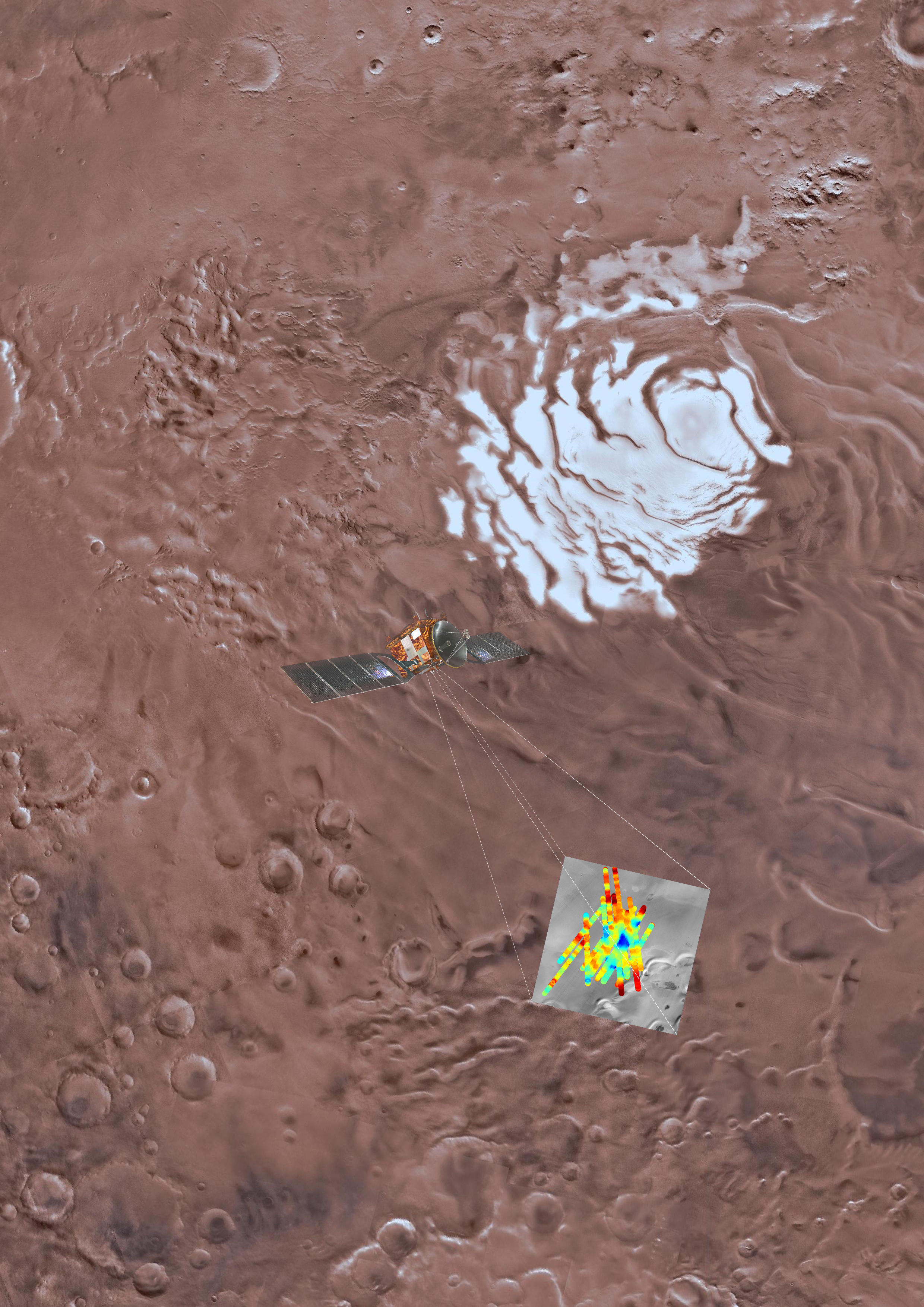Mars' South Pole May Hide a Large Underground Lake
The Red Planet just got quite a bit bluer, with scientists announcing the discovery of what they believe is a lake that's about 12 miles across and hidden below a mile (1.6 kilometers) of ice at the south pole of Mars.
Scientists have previously offered much weaker evidence for such reservoirs, as well as strong evidence for smaller amounts of water on the planet. But the new findings are still sure to make a splash.
"It's always exciting when you talk about liquid water on present-day Mars," Ashwin Vasavada, project scientist at NASA for the Curiosity mission, told Space.com. However, he declined to say how confident he is in the study's claims, because he isn't an expert in the kind of radar imagery the team used. "It's exciting because of any implications it might have for the habitability of Mars." [Geometry Helps Solve the Mystery of Mars' Water]
And it's too early to say what precisely those implications may be. Scientists still need to confirm the discovery itself and understand precisely what characteristics that water may have, which will require missions that have yet to be designed, much less launched.

Water below the ice?
The new research builds on more than three decades of theorizing by scientists about the chances that water lurks below Mars' polar caps, just as it does here on Earth.
That idea was first proposed by Steve Clifford, now a planetary scientist specializing in water on Mars at the Planetary Science Institute based in Arizona, who was not involved in the new research. He was inspired by scientists' studies of lakes below the Antarctic and Greenland ice sheets here on Earth, he told Space.com. Those lakes are created when heat from within the planet melts the glaciers in patches. He thought a similar scenario could be happening below the ice caps on Mars — we just didn't have any way to see below the ice.
The new research attempted to do just that using radar data gathered by an instrument called MARSIS, which uses pulses of radar to study the planet's ionosphere and interior structure. It has been orbiting the planet aboard Mars Express, a European spacecraft, since 2003.
Breaking space news, the latest updates on rocket launches, skywatching events and more!

The radar signals that MARSIS produces bounce back to Mars Express in different ways depending on what material they hit. And the team behind the new research said the signals MARSIS picked up over the south pole of Mars can be explained only by a large underground pool of liquid water.
"We discovered water on Mars," lead author Roberto Orosei, the co-investigator on MARSIS and a scientist at the National Institute for Astrophysics in Italy, said in a video released with the paper. "MARSIS was able to detect echoes from beneath the southern polar cap of Mars that were stronger than surface echoes. This condition on Earth happens only when you observe subglacial water like in Antarctica over places like Lake Vostok." And while the team only has evidence for the one location, they suspect it isn't the only such subglacial lake (Antarctica hides about 400 such features).
According to the radar echoes, the lake is no more than 12.5 miles (20 km) across and is buried about a mile below the surface of the ice cap. The scientists can't figure out precisely how deep the lake is, but they have confirmed that it is at least 3 feet (1 meter) deep. It must be rather salty, because the ice above it is quite clear and therefore quite cold — if there were pure water below that sort of ice, it would be frozen, the researchers said.
The team used data spanning three and a half years to make sure that their analysis included multiple passes over the same region. They also considered a couple other scenarios that might have explained the data they saw, including a layer of carbon dioxide ice hiding below the water ice. But the researchers said they came away unsatisfied with those explanations.
Other scientists may not agree. "I think it's a very, very persuasive argument, but it's not a conclusive or definitive argument," Clifford said. "There's always the possibility that conditions that we haven't foreseen exist at the base of the cap and are responsible for this bright reflection."
The research is described in a paper published July 25 in the journal Science.

Life means water, but water doesn't mean life
If future studies confirm that the mysterious layer below the ice is indeed water, scientists will have a host of further questions to tackle about the reservoir before they can make any predictions about what the discovery means for the possibility of life on Mars. [Curiosity Rover Finds Ancient 'Building Blocks for Life' on Mars]
"If you do have liquid water and you consider its relevance to life, then you also have to go beyond just the fact that it's liquid and ask the temperature that it's at and whether it's able to be used by life," Vasavada said. "Not all liquid water is equal in terms of life's ability to use it." In particular, he pointed to the high salt content that would be needed to keep water liquid at such low temperatures. This level might overwhelm even the most salt-loving life-forms, he suggested.
Scientists on Earth have drilled through glaciers to sample the water hiding below them and have found microbial life. So if there has ever been life on Mars, that life could theoretically have survived, hidden in this or similar lakes, Clifford suggested.
"There's no reason to expect that it wouldn't continue to the present day," he said of any ancient microbial life on Mars. "The subsurface is a very, very stable environment compared to the surface of a planet. It's protected from impacts. It's protected from climate change."
Email Meghan Bartels at mbartels@space.com or follow her @meghanbartels. Follow us @Spacedotcom, Facebook and Google+. Original article on Space.com.
Join our Space Forums to keep talking space on the latest missions, night sky and more! And if you have a news tip, correction or comment, let us know at: community@space.com.

Meghan is a senior writer at Space.com and has more than five years' experience as a science journalist based in New York City. She joined Space.com in July 2018, with previous writing published in outlets including Newsweek and Audubon. Meghan earned an MA in science journalism from New York University and a BA in classics from Georgetown University, and in her free time she enjoys reading and visiting museums. Follow her on Twitter at @meghanbartels.
